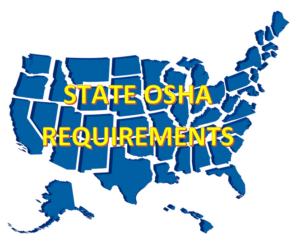
Don't Let These State OSHA Requirements Catch You By Surprise
Over half of the states and territories administer an approved State Plan OSHA Program, which means they have one or more OSHA standards that are unique to their state (one requiring a state OSHA poster, at a minimum). And some have added their own “twists” and additions to Federal OSHA standards. So, I thought I would share with you, in no particular order, what I consider to be some of the most unique, interesting, and/or quirky safety and health standards I’ve run across in various State Plan OSHA programs over the years:
Michigan (MIOSHA) Requirements
In the Wolverine state, rule 5815 (2) – (7) requires the operator of an aerial work platform (boom-lift . . .) to carry (or have available at the job site) an operators permit, issued by their employer, for the specific type lift they are utilizing. That permit is valid only while performing work for the issuing employer, and expires after three (3) years, at which time it must be re-issued. Federal OSHA has no operator’s permit or aerial lift operator training documentation requirement in their aerial lift standards.
Arizona (ADOSH) Requirements
State rule R20-5-628 specifies that an employer shall not use Polyvinyl Chloride (PVC) piping for the transportation and distribution of compressed air or other compressed gases in an above-ground installation. Federal OSHA has no such rule specifically forbidding the use of PVC (although they have been known to cite the General Duty Clause and reference applicable ANSI and ASME standards if sub-standard piping was used).
Washington (WISHA) Requirements
In this state, WAC 296-155-657 (1)(a)(ii) requires a protective system (shoring, trench box, sloping or benching . . .) is required for all excavations four (4) feet or deeper. The threshold in the federal OSHA excavation safety rule (and most other state regulations) is five (5) feet.
North Carolina (NCDOL) Requirements
Employee Safety and Health Committees must be established by all North Carolina employers having 11 or more employees and an experience rate modifier of 1.5 or above, per 13 NCAC 07A .0601 (b). Federal OSHA has no requirement for workplace safety committees.
New Mexico (OHSB) Requirements
In this state, the use of a hoe, knife, or fork less than four feet in length for weeding and thinning crops is prohibited, according to 11.5.4.10 A. You won’t find a federal rule on this topic at all.
Nevada (DIR NV-OSHA) Requirements
State OSHA rules NRS 618.983 (1) and (2) requires each person performing physical work on a construction site to complete an OSHA 10-hour construction course, while supervisors at construction sites must complete the OSHA 30-hour construction course. And both must retake their course (or an approved continuing education course) every five (5) years. These OSHA 10 and 30-hour Outreach courses are voluntary per the Federal OSHA.
Minnesota (MNOSHA) Requirements
This state requires hazard communication refresher training be conducted for all affected workers every year, per 5206.0700 (g)(4). Federal OSHA’s Haz-com standard does not have an annual refresher training requirement for employees.
Tennessee (TOSHA) Requirements
Staying with the topic of Hazard Communication, state rule 0800-1-9-.07 (4) requires employers to maintain written records of hazard communication training conducted for their employees. There is no employee training documentation requirement in the federal Haz-com standard.
Kentucky (KOSH) Requirements
Employees engaged in residential construction activities and who working ten (10) feet or more above a lower level near unprotected sides and edges, leading edges, a hoist area, on form work and reinforcing steel, or performing roofing work on roof slopes three (3) in twelve (12) or less must be protected by guardrail systems, safety net systems, personal fall arrest systems, or another measure provided in that section, according to 803 KAR 2:412. Section 3 (1)(a). The Federal construction standards for residential construction requires fall protection at heights of six (6) feet or greater.
Utah (UOSH) Requirements
State rule R614-7-2 (A) states that employees shall be furnished with and be required to use approved type safety harnesses and shall be tied off securely so as to suspend him above the level of the product before entering any bin, chute, or storage place containing material that might cave or run. Federal OSHA does not have a standard addressing this specific situation (although they do have a general confined space entry standard).
California (Cal-OSHA) Requirements
Anyone dealing with Cal/OSHA knows they are the grand-daddy of unique state OSHA standards. While there are many to choose from to discuss, I selected Subchapter 4, Article 29, 1710 (m)(3) from their steel erection standard. In California, connectors can move from work point to work point or release slings at fall distances greater than 30 feet or two stories, whichever is less, by “cooning” the beam (straddling the beam while walking with their feet on the lower flanges while sliding their hands across the top flanges). Federal OSHA rules for steel erectors requires the connector to utilize some sort of positive fall arrest system (like a harness with lanyard attached to an approved anchor point) when exposed to falls over 30 feet or two stories; cooning would not be allowed.
There is my list. There are certainly a lot more interesting state OSHA standards than just these, probably enough to even write a book on the subject. But I thought I better cap it at 10 for this blog. However, if you have a unique or quirky state-OSHA standard you would like to share, scroll all the way to the bottom of the page to the Comment Box. Last but not least, I encourage you to Share This Blog Post with Others in Your Network who might enjoy reading about this information.

